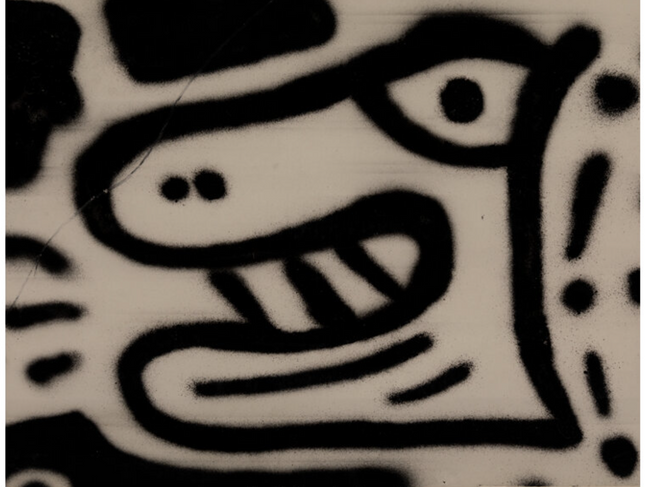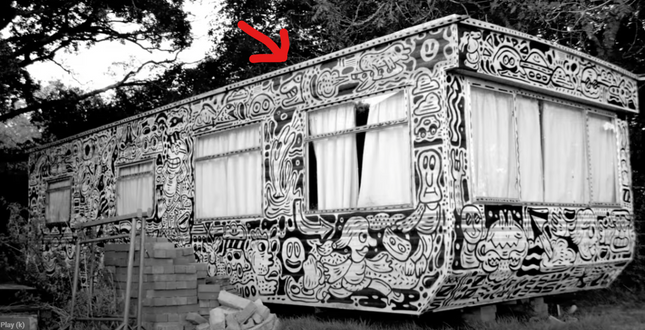
Street Art


Mr Doodle- Sam Cox Caravan Chaos Side 4 Panel 11 Original Spray Painting by Mr Doodle- Sam Cox
Caravan Chaos Side 4 Panel 11 Original Spray Paint Painting by Mr Doodle- Sam Cox One of a Kind Artwork on Aluminum Panel Mounted On Plywood by Street Art Pop Artist. 2015 Caravan Chaos Side 4 Panel 11 Original 1 of 2 Serial Numbered Spray Painting Original on Aluminum Panel Mounted Plywood Artwork Size 17.25x13.5. Natural Scuffing Lower Right; Residue Lower Right Inherent To The Medium & Media Used. Mr Doodle- Sam Cox's Unique Artistic Language In the dynamic world of pop art and street art, artists like Mr. Doodle, also known as Sam Cox, have carved out a niche with distinctive styles that blur the lines between art, doodling, and graffiti. Mr Doodle's "Caravan Chaos Side 4 Panel 11" is an original work that exemplifies this fusion, showcasing a unique visual language that is playful and meticulously detailed. This one-of-a-kind spray paint painting on an aluminum panel mounted on plywood stands out as a testament to the artist's skill and originality. Spray-painting directly onto an aluminum surface, Mr Doodle's "Caravan Chaos Side 4 Panel 11" is part of a larger body of work that portrays a chaotic yet harmonious world filled with interlocking characters and symbols. Measuring 17.25 by 13.5 inches, this artwork is a vibrant tableau of black and white, teeming with life and movement. The natural scuffing and residue are inherent to the medium and media used to add an extra layer of authenticity and rawness to the artwork. These imperfections are not drawbacks but integral elements contributing to the piece's storytelling. Exploring the Details of Caravan Chaos The intricate patterns and characters that seem to dance across the metal canvas make the artwork's complexity apparent. Each character is whimsically drawn, yet an underlying order to the chaos suggests a narrative or a snapshot of a larger, unseen universe. This snapshot is a classic example of how street art and pop art can transform everyday objects and materials into something extraordinary, a characteristic feature of Mr Doodle's artistic approach. The choice of materials in "Caravan Chaos Side 4 Panel 11" is crucial to understanding Mr Doodle's work. The aluminum panel offers a smooth surface that interacts uniquely with the spray paint, allowing for crisp lines and a stark contrast between the black and white hues. Mounted on plywood, the piece gains a sturdy backdrop, anchoring the ethereal doodles to a physical reality. The natural wear on the artwork suggests it has lived beyond the studio, perhaps even in the streets, where the essence of graffiti art is rooted. The Legacy of Mr Doodle's Caravan Chaos This piece by Mr. Doodle is not just a singular work of art but a fragment of a grander vision the artist has been developing over the years. His style is instantly recognizable and has become synonymous with the playful energy and spontaneity that pop art and street art strive to embody. "Caravan Chaos Side 4 Panel 11" is a frozen moment of this vision, inviting viewers to enter Mr Doodle's world—where art is seen and experienced. Sam Cox's contribution to the art world through his Mr Doodle persona is a vibrant chapter in the ongoing pop and street art story. His works, like "Caravan Chaos Side 4 Panel 11," are visually stimulating and a reminder of the power of art to transform and engage with its audience on multiple levels. As this piece stands, it is a celebration of creativity unleashed, a fitting piece for any collection that values the bold and the whimsical.
$3,000.00



